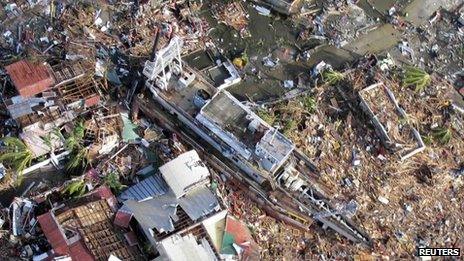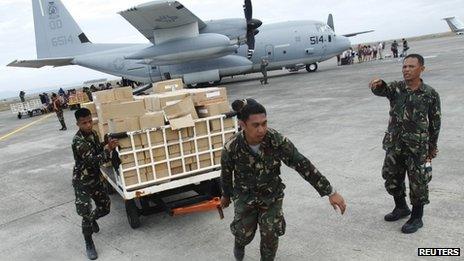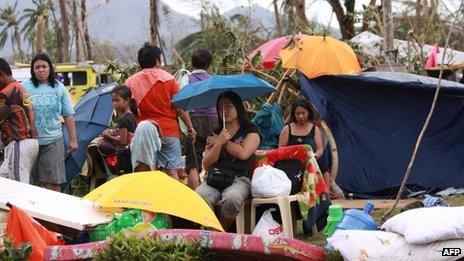Typhoon Haiyan aid: Co-ordination not duplication vital
- Published

Many people simply did not realise how devastating the storm surge would be, says Mike Wooldridge
Aid workers - tragically - have a wealth of experience to draw on when they are confronted with dealing with a disaster on the scale of the devastation and loss of life caused by the super-typhoon in the central Philippines.
However each disaster tests the national and international response in different ways.
The Philippines is particularly prone to natural disasters. In the path of Typhoon Haiyan lay places still in the throes of recovery from a destructive magnitude 7.2 earthquake which occurred only last month.
The government is well-practised at warning people of imminent typhoons, and on this occasion encouraged several hundred thousand people to move.
Given the strength of the typhoon, there were also warnings of the likelihood of a high storm surge.
But it seems that many may simply not have realised how devastating the storm surge would be. Those living in well-built homes may have imagined that they would be safe. But it proved to be a miscalculation.
And so while much about the impact of the disaster is not yet known, relief of every kind is clearly needed by the survivors. And in the case of food, clean drinking water and medicines, it is needed very rapidly.

Food, clean drinking water and medicines are needed desperately in central Philippines
The United Nations World Food Programme (WFP) is responsible for the logistics of the delivery of food and communications equipment, in support of the Philippines government.
WFP spokesman Greg Barrow says there are important elements in getting an aid "pipeline" of this kind operating as smoothly and as effectively as possible.
One danger to avoid, he says, is throwing too much aid at an affected area too soon, in a way that makes it difficult for it to be absorbed. A lesson learnt from the Asian tsunami, the Haiti earthquake and many other disasters is that proper co-ordination is vital.
Inevitable chaos
But there is a balance to be struck. With people as desperate and frustrated as they are in the worst-hit places in the Philippines disaster, aid officials also say you cannot wait to start delivering relief supplies - at the same time sharing plans and seeking to avoid duplication of effort.
Some chaos - at least in the early days of such a complex operation and with so many hungry people - may be inevitable.

After the immediate relief operation is finished, the authorities must turn their focus to recovery and reconstruction
If it turns out that it takes several days for some pockets of survivors - or significant numbers of further casualties - to be reached then it certainly will not be unprecedented.
In 1999, I reported on the aftermath of a super-cyclone in Orissa in eastern India - where winds reached almost the same speed, sustained over many hours.
Again, the cyclone created a massive wall of water in Orissa, surging inland further than anyone had thought imaginable. After several days army boats were still discovering communities washed away and the death toll continued to soar.
In many recent disasters mobile phones have played a key role - not only in people being able to contact loved ones but also in summoning help.
But in the Philippine disaster it is reported that many relay masts have been knocked out and - with power out in many places - even the charging of mobile phones will be highly problematic.
And if the emergency relief operation is daunting in so many ways, so too of course will be the longer term recovery and reconstruction.